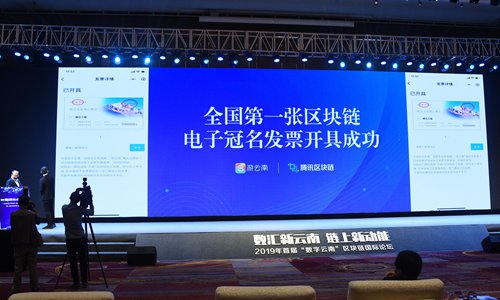HOME >> BUSINESS
Shanghai backs blockchain to enhance trade
By Xie Jun and Chi Jingyi Source:Global Times Published: 2019/11/7 22:28:41
Government-bank alliance seeks reliability, efficiency via data sharing

The first blockchain-based invoice for tourist attractions in Southwest China's Yunnan Province is issued at an international blockchain forum in July. Photo: VCG
Local Shanghai government departments and financial institutions have set up a blockchain alliance in Shanghai's E-port area to push the application of blockchain technologies to the city's international trade.
An E-port area blockchain alliance proposal was signed by the Shanghai Municipal Commission of Commerce, Shanghai Customs and representatives of six banks' branches in Shanghai, including the People's Bank of China, the nation's central bank, and the Bank of Communications, on Thursday during the second China International Import Expo (CIIE).
Various customs departments will join the blockchain network in the form of nodes and synchronize the clearing data of goods, which will optimize customs business management, Li Ming, director of the Blockchain Research Department at the China Electronics Standardization Institute, told the Global Times on Thursday.
A database based on blockchain technology can realize effective storage of customs documents, Li added.
Decentralization and distributed accounting features mean that blockchain is a technology that promotes information sharing, thereby improving the coordination of relevant parties in international trade, Chen Huifang, a professor at the College of Information Science and Electronic Engineering of Zhejiang University, told the Global Times on Thursday.
"Blockchain technology increases the reliability of information, thus improving the efficiency of customs clearance, reducing costs and promoting trade facilitation," said Chen.
Blockchain technology has been applied in several free trade zones in China, aiming to improve administrative efficiency, enhance trade convenience and increase trust among parties through blockchain-based transactions.
Ye Jian, an official from the General Administration of Customs of Shanghai, said that the application of blockchain technology can be seen as another aspect of China's push to optimize its business environment.
"This is the first blockchain application project in customs and the first service project for the CIIE. China upholds multilateral trade and constantly improves its business environment by seeking technological innovation," said Ye.
Chinese officials said at the CIIE that the nation will uphold the multilateral trading system and promote the construction of an open world economy. In the current world economic landscape, unilateralism and protectionism are on the rise, and economic globalization is encountering setbacks. The authority and effectiveness of the multilateral trading system are being challenged.
The cutting-edge blockchain technology has been applied to a number of business areas involved in Shanghai's international trade. These areas include digital insurance, the digital supply chain, the Internet of Things and intelligent manufacturing, said Shen Weihua, deputy director of the Shanghai Municipal Commission of Commerce.
According to Shen, Shanghai utilized blockchain technology for the new cross-border yuan trade financing services for the city's single window system. This application has helped solve information asymmetry during trade financing.
Shanghai is only one example of blockchain application for finance in China. At the end of October, a cross-border financial blockchain service platform began trials in Nanning, South China's Guangxi Zhuang Autonomous Region.
Qi Hong, vice director of China Construction Bank's Shanghai branch, told the Global Times that the application of blockchain in finance is still at the trial stage in China.
"We now use blockchain in one-off products instead of the whole finance industry chain, and the public doesn't have a sound understanding of the technology when it comes to financing. But I think the government's call for blockchain construction will help push the technology's application in a more comprehensive way."
She also said that China Construction Bank will continue to use blockchain to enhance its management and reduce costs.
Posted in: INDUSTRIES